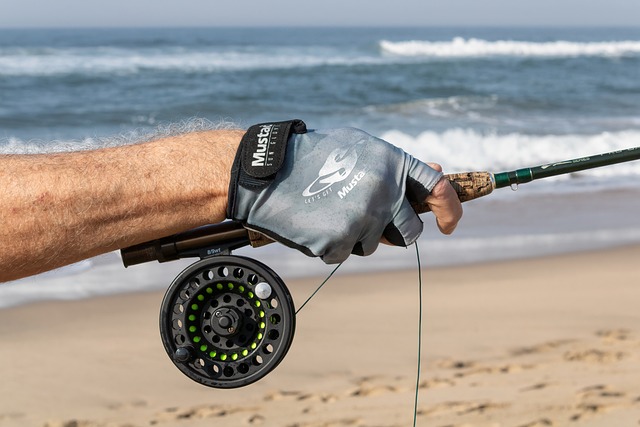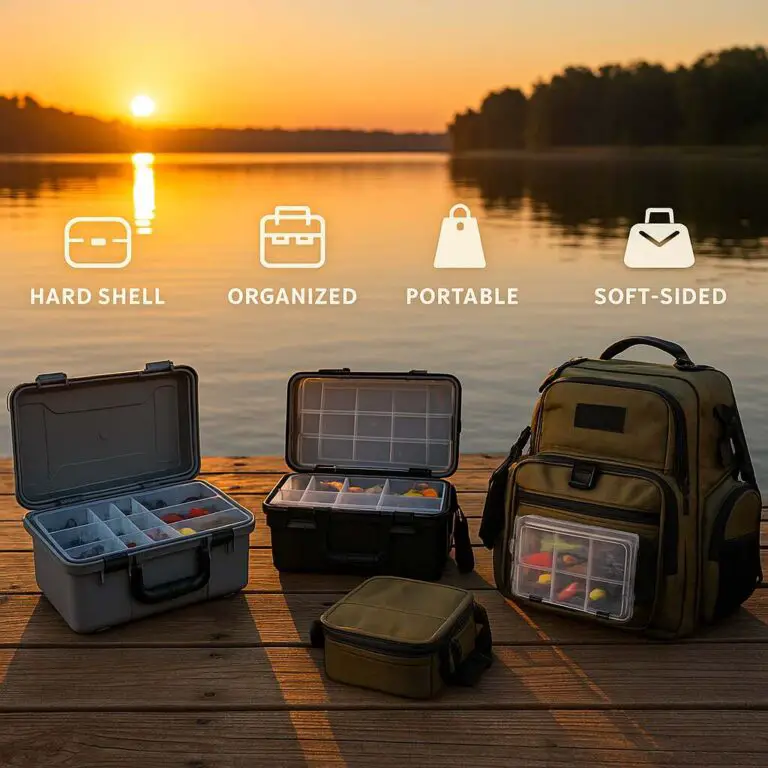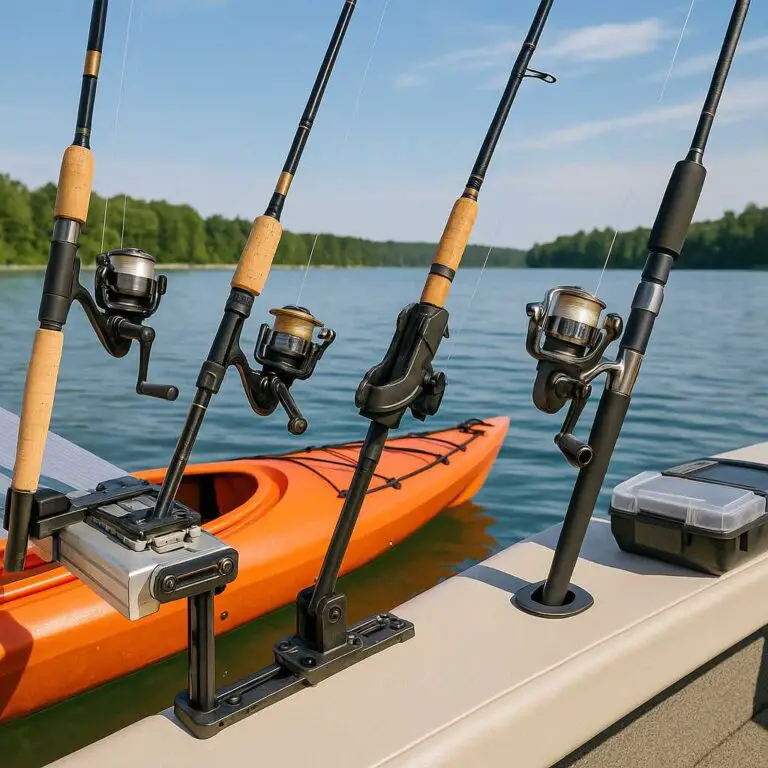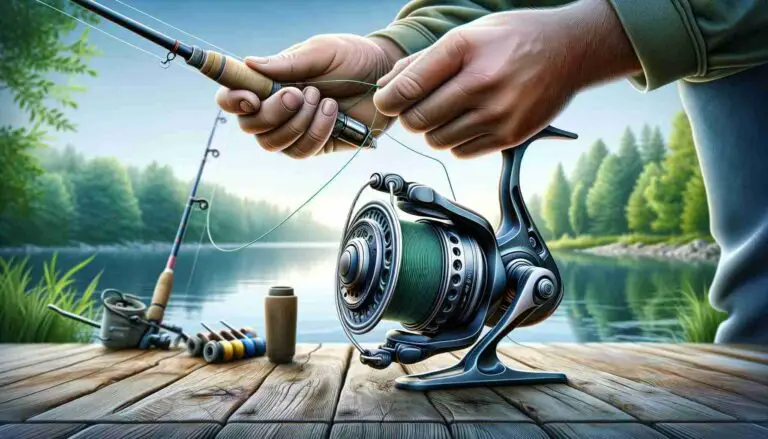Hey there! If you’re anything like me, the thrill of fly fishing is more than just a hobby; it’s a passion. But here’s the thing – the right equipment can make all the difference between a successful day on the water and a frustrating one. Choosing the perfect fly rod and reel combo isn’t just about picking any old rod off the rack; it’s about finding a partner that complements your skills, suits your fishing goals, and feels like an extension of yourself. So, How to Choose the Perfect Fly Rod and Reel?
Selecting the perfect fly rod and reel requires a balanced approach. Begin by identifying your target species and fishing environment. Match your rod weight to the species; lighter rods (1-4) for smaller fish, heavier rods (7-12) for larger ones. Choose a rod length based on your fishing location, shorter for tight spaces, longer for open water. Ensure your reel complements your rod in terms of size and capacity.
But this is not so helpful, right? That’s why in this article, I’ll cover everything you need to know, from understanding the basics to delving into the nitty-gritty details. Keep reading!
Understanding the Basics
Before I dive headfirst into the world of fly rods and reels, it’s crucial to lay down the foundation by understanding the basics. Think of this section as the ABCs of fly fishing gear.
What is a Fly Rod and Reel?
A fly rod and reel are the dynamic duo at the heart of every fly angler’s toolkit. They’re like the Batman and Robin of the fishing world, each with its unique role.
- Fly Rod: Your fly rod is your casting tool, your wand if you will. It’s a long, slender piece of equipment designed to cast the fly line, leader, and fly accurately. Fly rods come in various lengths and weights, and they’re often constructed from materials like graphite, fiberglass, or bamboo.
- Fly Reel: The fly reel, on the other hand, is your trusty sidekick, responsible for holding the fly line and providing resistance when a fish takes the bait. While not as glamorous as the rod, it plays a crucial role in reeling in your catch. Fly reels can be single-action or multiplier (more on that later), and they’re typically made from materials like aluminum or carbon fiber.
The Key Components of a Fly Rod
Now, let’s break down a fly rod into its key components:
- Rod Blank: This is the main body of the fly rod, and it determines its length, weight, and action. Rod blanks are usually made from materials like graphite or fiberglass, with each material offering its unique set of characteristics.
- Guides: Guides are the circular rings along the length of the rod. They guide the fly line during casting and retrieval, helping it flow smoothly. They’re typically made of materials like ceramic or stainless steel.
- Reel Seat: The reel seat is where you attach your fly reel to the rod. It’s a crucial interface that keeps your reel securely in place.
- Handle and Grip: The handle or grip is where you hold the rod. It’s often made of cork or foam, providing comfort and control during casting.
Different Types of Fly Reels
Fly reels may look similar at first glance, but they come in different types, each suited to specific fishing scenarios. Here are some common types:
- Single-Action Reels: These reels have a simple design with a spool that rotates as you reel in your line. They’re known for their reliability and ease of use.
- Multiplier Reels: Multiplier reels have a more complex mechanism, allowing the spool to rotate faster than the handle. They’re often used for saltwater or big-game fishing where quick line retrieval is crucial.
- Click-and-Pawl Reels: These classic reels produce a distinct clicking sound when a fish takes a line. They’re cherished by purists for their simplicity and nostalgia.
In the next section, I’ll delve into the first step of choosing the right fly rod and reel: determining your fishing goals.
Step 1: Determining Your Fishing Goals
Before you can select the perfect fly rod and reel, you need to understand your fishing goals. Think of this step as setting the destination on your angling adventure map – it will guide you in choosing the right gear for your specific needs.
Defining Your Fishing Objectives
- Species of Interest: Begin by identifying the primary species of fish you plan to target. Are you after trout, bass, salmon, or something more exotic like tarpon or bonefish? Different fish require different equipment.
- Fishing Environment: Consider where you’ll be fishing most often. Will it be in freshwater rivers and streams, tranquil lakes, or the saltwater flats? The environment significantly impacts your gear choices.
- Casting Preferences: Think about your preferred casting style. Do you enjoy delicate presentations with dry flies, or are you more into long-distance casting with streamers? Your casting preferences influence your rod and line choices.
Understanding the Importance of Fly Rod Weight
- Rod Weight Classification: Fly rods are classified by weight, usually ranging from 1 to 12 (and beyond). Lighter rods (1-4) are suitable for smaller fish and delicate presentations, while heavier rods (7-12) are designed for larger species and stronger casts.
- Matching Rod Weight to Target Species: Match your rod weight to the species you plan to pursue. For example, a 4-weight rod is excellent for trout in small streams, while a 9-weight is better suited for battling saltwater species.
- Versatility Considerations: If you’re unsure about your primary fishing objectives or if you want a versatile rod, a 5 or 6-weight rod is an excellent starting point. It can handle a wide range of fishing scenarios.
Understanding your fishing goals and the concept of rod weight sets the stage for selecting the right fly rod.
Step 2: Choosing the Right Fly Rod Weight
Now that you’ve defined your fishing goals and have a clear understanding of what species you want to target, it’s time to delve into the world of fly rod weights. Think of this step as selecting the right tool for the job – in this case, the weight of your fly rod.
Explanation of Fly Rod Weight Classifications
- The Weight Scale: Fly rods are categorized by a weight scale, typically ranging from 1 to 12, although there are variations outside this range. The weight rating indicates the rod’s power and its ability to cast specific line weights.
- Lighter Weights (1-4): These are your finesse rods, perfect for delicate presentations on small streams and for pursuing smaller fish like trout and panfish. They excel in situations where precision casting is essential.
- Midrange Weights (5-7): These rods offer versatility. A 5 or 6-weight rod is an excellent choice for anglers who want a rod that can handle a variety of fishing scenarios, from small to medium-sized species in different environments.
- Heavier Weights (8-12 and beyond): As you move up the scale, the rods become more robust. These rods are designed for big-game fishing and tackling larger species like salmon, steelhead, bass, and saltwater gamefish.
Matching Rod Weight to Target Species
- Consider Your Target: Refer back to your fishing objectives. If you plan to catch trout in mountain streams, a 3 or 4-weight rod is ideal. If you’re chasing after bonefish in saltwater, an 8 or 9-weight rod is better suited to handle the fight.
- Line Weight Match: Your rod weight should match your fly line weight. For example, a 5-weight rod pairs with a 5-weight fly line. This ensures the rod’s casting action and the line’s performance are in sync.
- Balance and Feel: Don’t forget about how the rod feels in your hand. Visit a local fly shop and test-cast rods of different weights to find the one that feels comfortable and responsive to you.
Tips for Versatile Rod Weight Selection
- Starting with a 5 or 6-Weight: If you’re new to fly fishing or want a versatile all-around rod, a 5 or 6-weight is often recommended. It can handle a wide range of fishing situations, making it an excellent choice for beginners.
- Considering Multiple Rods: If you plan to fish for various species or in different environments regularly, investing in multiple rods of varying weights might be the way to go. This allows you to fine-tune your gear to specific conditions.
- Seeking Expert Advice: Don’t hesitate to consult with experienced anglers or visit a fly shop for guidance. They can provide valuable insights based on local conditions and personal preferences.
Selecting the right fly rod weight is a crucial step in building your perfect fly fishing setup. With this knowledge in hand, you’re well on your way to making an informed decision.
Step 3: Selecting the Ideal Fly Rod Length
Now that you’ve determined the appropriate weight for your fly rod, it’s time to focus on another critical aspect of rod selection: the length. Think of rod length as the fine-tuning knob on your fishing radio – it can make a significant difference in your casting and overall fishing experience.
Understanding the Relationship Between Rod Length and Casting Distance
- Longer Rods for Distance: Generally, longer fly rods allow for more extended casting distances. This can be advantageous when you need to reach distant feeding lanes or when fishing on larger bodies of water like lakes or rivers.
- Shorter Rods for Precision: Conversely, shorter rods provide more precision and control. They excel in situations where you need to make accurate casts in tight quarters, such as small streams with overhanging vegetation.
Tailoring Rod Length to Fishing Conditions
- Small Streams (6-8 feet): For navigating tight, brush-lined streams, opt for a short rod in the 6 to 8-foot range. This will help you avoid snagging your line on vegetation and make delicate presentations easier.
- Medium Streams and Rivers (8-9 feet): When fishing in moderate-sized streams or rivers, an 8 or 9-foot rod strikes a balance between casting distance and precision. It’s a versatile choice for a wide range of situations.
- Large Rivers and Lakes (9-10 feet and longer): If you’re targeting fish in larger bodies of water, a longer rod in the 9 to 10-foot range can provide the casting power needed to cover more water effectively.
Balancing Portability and Performance
- Travel Considerations: If you plan to travel frequently with your fly rod, consider a rod that breaks down into multiple sections. These travel-friendly rods are designed for easy packing and transportation.
- Trade-Offs: Keep in mind that longer rods may offer more casting distance, but they can also be less convenient in tight spaces. Conversely, shorter rods excel in close-quarters casting but may limit your reach.
- Personal Comfort: Ultimately, your comfort with the rod’s length matters. Test-casting different lengths to find the one that feels right for you is essential. Your casting style and fishing environment can influence this decision.
In the next step, I’ll dive into the world of selecting the perfect fly reel to complement your fly rod, so stay tuned for more angling wisdom!
Step 4: Picking the Perfect Fly Reel
Now that you’ve got a handle on choosing the right fly rod, it’s time to explore its trusty sidekick: the fly reel. Think of the fly reel as your fishing companion who’s always ready to lend a hand (or, in this case, a pawl). Let’s dive into the factors that will help you pick the perfect fly reel.
Exploring Different Reel Types
- Single-Action Reels: These reels are known for their simplicity and reliability. With a single-action reel, one turn of the handle equals one turn of the spool. They’re easy to use and are often the choice for those who appreciate a classic, no-nonsense design.
- Multiplier Reels: Multiplier reels offer a more complex mechanism. The spool can rotate faster than the handle, making them suitable for situations where quick line retrieval is crucial, such as saltwater fishing or when battling large, fast fish.
- Click-and-Pawl Reels: If you’re a purist who loves the nostalgic sound of a reel’s click and pawl drag system, these reels are for you. They provide a simpler form of drag and are often prized for their elegance.
The Importance of Reel Size and Capacity
- Matching Reel Size to Rod: Ensure that your fly reel complements your fly rod in terms of size and weight. A well-balanced setup enhances your casting and overall fishing experience.
- Backing Capacity: Consider the amount of backing your reel can hold. This is important when you hook into a fish that takes off on a long run. Make sure your reel can accommodate enough backing to prevent running out of line.
- Arbor Design: Reel arbors come in different shapes, including standard, mid-arbor, and large-arbor. A large-arbor design offers faster line retrieval, while standard arbors have more capacity. Mid-arbor designs aim for a balance between the two.
Evaluating Reel Materials and Construction
- Material Matters: Fly reels are commonly made from materials like aluminum, carbon fiber, or composite materials. Aluminum reels are durable and lightweight, making them a popular choice for most anglers.
- Drag System: Pay close attention to the reel’s drag system. It’s responsible for controlling the tension on your line when a fish runs. Disc drags are the most common and offer smooth and reliable performance.
- Maintenance: Consider how easy it is to maintain the reel. Some reels have simple designs that are easy to clean and service, while others may require more intricate maintenance.
Step 5: Choosing the Right Fly Line
Now that you have a fly rod and reel in mind, it’s time to complete your setup by selecting the perfect fly line. Think of fly line as the communication link between you and the fish – it’s essential for casting accuracy and effective presentation.
The Role of Fly Line in Fly Fishing
- Essential for Casting: Fly line is the weight that loads your fly rod during casting. Without it, you couldn’t deliver your fly to the target.
- Presentation: Different types of fly lines are designed for specific fishing situations, allowing you to present your fly effectively to fish.
- Sink Rates: Fly lines come in various sink rates, from floating to fast-sinking. Your choice of line will impact the depth at which your fly rides in the water.
Understanding Fly Line Weight Ratings
- Weight Ratings: Fly lines are categorized by weight ratings, typically ranging from 1 to 12 (and beyond). Just like fly rods, the weight rating of your fly line should match the weight of your fly rod.
- Balanced Setup: Matching your fly line’s weight to your rod ensures a balanced setup that casts smoothly and accurately. For instance, if you have a 5-weight rod, you should use a 5-weight fly line.
Matching Fly Line to Your Rod and Reel
- Consider the Taper: Fly lines have different tapers, such as weight-forward, double taper, and shooting head. Weight-forward tapers are versatile and work well for most anglers and situations.
- Specialty Lines: Some fishing scenarios require specialty lines. For example, if you’re into saltwater fly fishing, you might need a saltwater-specific fly line designed to withstand harsh conditions.
- Review Line Reviews: Check reviews and recommendations from experienced anglers or consult with your local fly shop to find the right line for your setup and fishing goals.
Tips for Choosing Fly Line Weight
- Dry Fly Fishing: If you primarily use dry flies and need delicate presentations, a floating weight-forward line is usually the go-to choice. It’s designed for precision and control.
- Nymphing or Streamer Fishing: For nymphing or streamer fishing where you might need to get your fly down quickly, consider a sinking-tip or full-sinking line with the appropriate sink rate.
- Versatility: If you’re looking for an all-around line, a weight-forward floating line in a weight that matches your rod is a versatile option. It can handle a variety of fishing scenarios.
Choosing the right fly line may seem daunting, but it’s a crucial step in crafting your ideal fly fishing setup. With the right line, you’ll be ready to hit the water and start honing your casting skills.
Step 6: Finding the Perfect Fly Fishing Line Weight
Now that you’ve chosen a fly line that matches the weight of your fly rod, it’s time to dive deeper into the intricacies of selecting the perfect fly line weight. Think of this step as fine-tuning your musical instrument to produce the sweetest notes during your fishing symphony.
Delving Deeper into Line Weight Considerations
- Understanding Line Weight: Fly lines are categorized by both their overall weight (which matches the rod weight) and a more specific line weight classification. Line weight classifications include terms like “4-weight,” “5-weight,” and so on. This specific classification relates to the grains of the first 30 feet of line and impacts your casting and fishing experience.
- Fine-Tuning Your Presentation: The specific line weight you choose can affect your casting ability and presentation. A line with a slightly heavier or lighter weight classification can fine-tune your cast for specific fishing conditions.
- Versatility vs. Specialization: Consider whether you want a line that excels in a particular style of fishing or one that’s versatile enough to handle various situations. Versatile lines with slightly different weights can offer adaptability.
Factors Affecting Line Weight Choice
- Wind Conditions: If you frequently fish in windy conditions, you might opt for a slightly heavier line to improve your casting accuracy and control.
- Fly Size and Weight: The size and weight of the flies you plan to use also influence your line choice. Heavier flies require a slightly heavier line to load the rod effectively.
- Casting Skill Level: Your casting skill level plays a role. A slightly heavier line can be forgiving for beginners, making it easier to load the rod and cast accurately.
Navigating the Balance Between Casting and Presentation
- Balanced Rig: Striking the right balance between line weight and rod weight is crucial for a balanced setup. An overly heavy line can overload the rod, making it challenging to cast accurately.
- Experiment and Adapt: Don’t be afraid to experiment with different line weights to see how they impact your casting and presentation. Sometimes, a minor adjustment can significantly improve your performance.
- Seek Expert Advice: Consult with experienced fly anglers or visit a fly shop for guidance on line weight selection. Local knowledge and personal experience can provide invaluable insights.
Step 7: Ensuring Compatibility Between Rod, Reel, and Line
Now that you’ve made individual selections for your fly rod, reel, and line, it’s time to ensure they work harmoniously together as a cohesive unit. This step is all about achieving the perfect synergy between your gear to maximize your fishing experience.
The Importance of Balance in Your Setup
- Balanced Performance: A balanced setup is one where your rod, reel, and line complement each other perfectly. It ensures that you can cast accurately, control your line effectively, and fight fish with confidence.
- Casting Efficiency: When your rod, reel, and line are balanced, you’ll experience improved casting efficiency. Your casts will be smoother, more accurate, and require less effort.
Tips for Checking Compatibility
- Rod and Line Matching: Confirm that your fly line matches the weight rating of your fly rod. For instance, if you have a 5-weight rod, make sure you’re using a 5-weight fly line.
- Reel and Line Compatibility: Ensure that your reel has the capacity to hold the amount of fly line and backing you plan to use. Overfilling or underfilling the reel can affect performance.
- Balancing the Setup: Assemble your rod, reel, and line, and pay attention to how the entire setup feels in your hand. It should feel comfortable and well-balanced.
Adjusting Components as Needed
- Adding or Removing Backing: If you find that your reel is overfilled or underfilled with backing and fly line, you can adjust the amount of backing to achieve the right balance.
- Changing Line Weight: If you discover that your fly line weight doesn’t match your rod as expected, consider swapping it for a different line that better suits your setup.
- Reel Selection: If your reel is too heavy or too light for your rod, you might need to explore reel options that better match the overall weight and balance of your setup.
Fine-Tuning for Personal Preferences
- Casting Style: Your personal casting style and preferences also play a role in how your setup feels. Some anglers prefer a slightly heavier or lighter line to accommodate their style.
- Fishing Environment: Consider whether you’ll primarily fish in windy conditions, still water, or fast-flowing rivers. These environmental factors may influence your balance preferences.
- Seeking Feedback: Don’t hesitate to seek feedback from experienced anglers or attend casting clinics to fine-tune your setup for optimal performance.
Achieving compatibility and balance between your fly rod, reel, and line is the key to unlocking the full potential of your fly fishing setup. It ensures that your gear works seamlessly together, allowing you to focus on what matters most – the joy of fishing.
Step 8: Considering Specialized Rods – Tenkara
In this step, we’ll explore a unique and specialized form of fly fishing – Tenkara. Tenkara is an ancient Japanese method that has gained popularity worldwide for its simplicity and effectiveness. Let’s dive into the world of Tenkara fly fishing and learn how to choose the right Tenkara rod.
Introduction to Tenkara Fly Fishing
- What is Tenkara? Tenkara is a minimalist style of fly fishing that originated in Japan. It involves using a long, telescopic rod, a fixed length of line, and a fly to catch fish. Tenkara emphasizes simplicity, precision, and a deep connection with nature.
- Key Tenkara Elements: Understanding the core elements of Tenkara is essential. These include the Tenkara rod, Tenkara line, tippet, and the specific casting and presentation techniques unique to this style.
How to Choose the Right Tenkara Rod
- Length of the Rod: Tenkara rods come in various lengths, typically ranging from 8 to 15 feet or more. The length you choose depends on your fishing environment and personal preferences.
- Shorter Rods (8-11 feet): These are ideal for small streams and tight spaces, offering precision and control.
- Medium-Length Rods (11-13 feet): They strike a balance between reach and maneuverability, making them suitable for a variety of fishing scenarios.
- Longer Rods (13+ feet): Longer rods excel in larger rivers and when you need extended reach for better line control.
- Action and Flexibility: Consider the action of the rod. Tenkara rods are often categorized as either fast, medium, or slow action. Fast-action rods are more rigid and better for larger fish, while slow-action rods provide a delicate touch for smaller fish and light presentations.
- Material and Construction: Tenkara rods are typically made from materials like carbon fiber or fiberglass. Carbon fiber rods are lightweight and provide excellent sensitivity, while fiberglass rods offer a more traditional feel.
- Telescopic vs. Collapsible: Most Tenkara rods are telescopic, allowing them to extend to their full length when in use and collapse for storage and transport. Choose a design that suits your travel and storage needs.
Pros and Cons of Tenkara Fishing
- Advantages of Tenkara:
- Simplicity and ease of use.
- Precise presentations and delicate casts.
- Minimalist gear setup, perfect for backpacking or traveling.
- Ideal for small to medium-sized fish, such as trout.
- Considerations:
- Limited reach compared to traditional fly fishing.
- Not suitable for larger or heavier species.
- Specialized gear may not be as versatile for different fishing environments.
Choosing the right Tenkara rod involves considering your fishing environment, preferred casting style, and the type of fish you intend to target. Tenkara can be a rewarding and meditative form of fly fishing, offering a unique connection to nature and a simplified approach to angling.
Conclusion
In conclusion, selecting the right fly fishing gear is not just about equipment; it’s about crafting an experience. Your fishing goals, the species you seek, and the environments you explore all play a role in shaping your gear choices.
As you venture out into the water, keep these key takeaways in mind:
- Fishing Goals: Define your fishing objectives clearly. Knowing what you aim to achieve on the water will guide your gear selections.
- Rod Weight: Choose a fly rod weight that matches your target species and fishing conditions, balancing power and finesse.
- Rod Length: Tailor the length of your rod to your fishing environment, whether it’s a small stream, a meandering river, or a vast lake.
- Fly Reel: Select a fly reel that complements your rod and provides adequate backing capacity, ensuring a balanced setup.
- Fly Line: Match your fly line’s weight to your rod and consider its taper and sink rate to suit your casting style and presentation needs.
- Line Weight: Delve into the specifics of fly line weight classifications to fine-tune your casting and presentation.
- Compatibility: Ensure that your rod, reel, and line are well-matched and balanced, considering personal preferences and fishing conditions.
- Tenkara Fishing: Explore the unique world of Tenkara fishing for a simplified, minimalist approach that connects you deeply with nature.
Your journey as an angler is a continuous learning experience, and as you spend more time on the water, your gear choices may evolve to meet your changing needs and preferences. Seek advice from fellow anglers, attend casting clinics, and, most importantly, relish every moment you spend fly fishing.
The thrill of a perfectly executed cast, the anticipation of the strike, and the connection with the natural world are what make fly fishing a truly remarkable pursuit. So, cast away, and may your fishing adventures be filled with joy, serenity, and bountiful catches!
Here is another article that you may be interested in reading: The Significance Of Fly Rod Weight








